
GLENN LONEY'S SHOW NOTES
By Glenn Loney, July 6, 2002

|
|
|
Caricature of Glenn Loney by Sam Norkin. |
|
[02] Shakespeare in Central Park: Where Art Thou Now?
[03] Bard Hidden in Boulder
[04] Ashland's Innovative "New Theatre"
[05] Sherwood's 1936 "Idiot's Delight" Still Timely
[06] Faith-Based Snake-Handling in "Handler"
[07] "Macbeth" Bloodbath in Oregon
[08] SF Hippies in OSF "Winter's Tale"
[09] Human Fast-Food in "Titus Andronicus"
[10] Shakespeare's Rhetorical Set-Pieces Shine in "As You Like It"
[11] Ashland's OSF 2003 Season Preview
[12] Is Ashland "Too Good To Last?"
[13] Chicago Shakespeare on Navy Pier: "Tempest" Flies
[14] Manhattan End-of-Season Roundup
You can use your browser's "find" function to skip to articles on any of these topics instead of scrolling down. Click the "FIND" button or drop down the "EDIT" menu andchoose "FIND."
How to contact Glenn Loney: Please email invitations and personal correspondences to Mr. Loney via Editor, New York Theatre Wire. Do not send faxes regarding such matters to The Everett Collection, which is only responsible for making Loney's INFOTOGRAPHY photo-images available for commercial and editorial uses.
How to purchase rights to photos by Glenn Loney: For editorial and commercial uses of the Glenn Loney INFOTOGRAPHY/ArtsArchive of international photo-images, contact THE EVERETT COLLECTION, 104 West 27th Street, NYC 10010. Phone: 212-255-8610/FAX: 212-255-8612.
For archival versions of Glenn Loney's past columns, please try our internal search engine.
A Shakespeare Tale of Two Cities-
Followed By "The Last Roundup"
Before the NYC/USA Fall Season
On the Track of the Bard Long, Long Ago:
Some thirty years ago, I spent most of my summer scouring the United States and Canada for SHAKESPEARE FESTIVALS. This trial of endurance-how many Twelfth Nights and Midsummer Night's Dreams can you see in one summer?-was my own initiative, intended for publication in THEATRE CRAFTS.I had already spent a week with the Ringling Bros & Barnum-Bailey Circus, hoping to expand our coverage of technical & design aspects of theatrical events beyond Broadway. That was a really interesting issue!
At the time, Patricia Mackay-editor of Theatre Crafts-and I were virtually writing all the features and reports. So any change from the New York, Regional, & University Theatre Scenes was a welcome and often innovative diversion.
In the event, we compiled so much information about North American Shakespeare Festivals that we had to devote an entire issue to them. Now a Collector's Item!
But then there was so much information-and so many photos-left over that we brought them all together in a book: THE SHAKESPEARE COMPLEX, published in 1972, by Drama Books-and long out-of-print. [An unexpected dividend of this Shakespeare Adventure was the long & happy marriage of Editor Mackay and Publisher Ralph Pine. They met for the first time when I brought Pat to pitch the book to Ralph!]
In recent years, with the spread of Summer-and now Winter-Shakespeare Festivals, a new look in book-format seems increasingly important. Five new festivals were launched shortly after our book appeared. And more have been created over the decades, even as some older fests have died or languished. It's time to Take Stock and provide an up-to-date report!
But this needs to be done by a much younger roving arts-journalist than I. And one with the technical-theatre knowledge required to report on innovations in design, construction, lighting, & sound. And the "smarts" to explain how the relatively new area of Performing Arts Management benefits each festival.
Such a book would be immensely valuable not only Shakespeare Fans & Summer Tourists, but also for theatre professionals, looking for new ideas and possibly even employment. Drama students would certainly find such a book useful as a source of summer internships.
Who will be the new Chronicler of Shakespeare in North America?
Shakespeare Summer 2002:
Two Fests Seen/Two Missed-
I have neither the time nor the energy to cover all the extant Bardic Festivals.
I regret that I have not been to the Stratford Festival of Canada
in years. But July and August now find me every summer at the major European
Music Drama & Theatre Festivals.
I do make a point of traveling to Ashland every June for the opening of the Oregon Shakespeare Festival and its Outdoor Elizabethan Theatre season of Shakespeare revivals. Initially, I began this annual trek because a number of talents involved were either fellow-students or professors at Stanford University. Ashland's longtime principal theatre-architect and stage-designer, Richard L. Hay, is one of these admired Stanford Alums.
It was pure serendipity, however, that I was recently able to enjoy a magical & magisterial staging of The Tempest, one of the remarkable productions of the Chicago Shakespeare Company. This was mounted & flown in its dazzling new "Cockpit" theatre, modeled after the Swan Theatre in Stratford-Upon-Avon.
The American Theatre Critics Association was in the Windy City for some equally windy panels and a representative sampling of stagings by leading Chicago theatre ensembles, some in stunning new venues. Of which, more later, Post-Bard…
Shakespeare in Central Park, Whither/Wither Art Thou?
Usually, I am able to see two out of three of the New York Shakespeare Festival/Public Theatre's summer Central Park stagings in the Delacorte Theatre. I bracket the first and the last around the European fests.This summer, however, there is only ONE PRODUCTION in the Delacorte. It is Twelfth Night, and it is not open to the press until 25 July! And it will close before I've returned from the Edinburgh Festival.
Fortunately, I have surely seen many more than 50 productions of this comedy in over half-a-century of play-reviewing & theatre-reportage. So I do know how it comes out…
[How about a revival of Danny Apolinar's musical version of Twelfth Night: Your Own Thing? The times seem just right!]
NYC Shakespeare Festival Founder Joe Papp would be furious with the current programming. What has happened to his dream of Free Shakespeare in Central Park?
Is the new one-production-per-summer policy a failure of nerve-or of funding? Or is Public Theatre Artistic Director George C. Wolfe really more interested in such Broadway production adventures as The Wild Party and Topdog/Underdog?
An even greater irony is the increasing popularity of Heineken's SUMMER STAGE, just off Fifth Avenue at 72nd Street in Central Park! All summer long-virtually on my doorstep-constantly changing programs of music, opera, drama, and readings are available free.
Can this newer Central Park fest share its funding & programming secrets with Wolfe and the fading New York Shakespeare Festival?
The Hidden Bard in Boulder-
The second American Shakespeare Festival I missed this summer was not for want of trying to find out if it was still alive and well. This is the Colorado Shakespeare Festival, which was splendidly innovative all those years ago when I hitch-hiked to Boulder, Colorado, to check it out.At that time, I was both delighted and impressed by Artistic Director Edgar Reynolds' novel staging of The Winter's Tale, on a platform-stage enclosed by four University of Colorado classroom-buildings. Reynolds envisioned the three sequences of this dark comedy in the Past, the Present, and the Space-Age Future. It was magical…
Visiting family in nearby Golden-home of the immense Coors Brewery-I could find no listings or ads for the Boulder fest in either the Denver Post or the Rocky Mountain News. The Boulder Dinner Theatre, however, had both ads & listings.
No one I asked had ever heard of a Colorado Shakespeare Festival. Although they certainly knew about the University in Boulder and the Colorado School of Mines in Golden.
Finally-when it was too late to manage a free evening before my return to New York-I got over to Boulder only to discover that the season had already opened the previous night with Macbeth.
After 30 years, both Boulder and the U of C campus looked rather different. I couldn't find the amphitheatre. Nor could anyone I met on campus give me accurate directions. I went off on three wild-goose-chases.
At last, following some stage-hands with a large prop, I stumbled through the walled-enclosure into the handsome arena I remembered from so long ago. Apparently, audiences make their entrances through or by a building which was closed.
No brochures were on hand in the theatre.
There was no sign at all to indicate where the box-office might be. A stage-hand gave me imprecise directions.
I finally found it in the basement of a flanking building, under an imposingly grim outside staircase. It was, in fact, open-but who would have been able to find it? Especially if people on campus seemed to have no idea where the amphitheatre was actually located?
For the record, this summer season-under Colorado skies in the Mary Rippon Outdoor Theatre-Shakespeare fans will be able to see Macbeth, Midsummer Night's Dream, & Richard III.
A collage called Shakespeare in Briefs! is being staged indoors on the Main Stage of the University Theatre. This will then travel to romantic Vail for a short stint in the Vilar Center for the Performing Arts. Can this venue be named for the munificent patron, Alberto Vilar, who has so generously lent his patronymic to the Royal Opera, Covent Garden, and the Metropolitan Opera?
 |
| A VIEW
OF DICK HAY'S NEW THEATRE- photo by Jennifer Reiley. |
A New "New Theatre" in Ashland!
The Big News at the Oregon Shakespeare Festival is that its New Theatre-replacing the old but far too small black-box theatre, the Black Swan-is a big success!For its inaugural season, theatre-architect Richard L. Hay has designed each of its three innovative productions using a different seating-conformation. But Hay says this was not deliberately done to demonstrate the unusual flexibility of the auditorium.
Rather, when he studied each of the three scripts, he chose a design-conformation which he believed would best suit the plays. Thus, Festival Artistic Director Libby Appel's unusual condensation and staging of Macbeth is performed in a squared arena seating-well.
Hay's artistic vision complements this with another kind of well. The action takes place on and around a two-level circular platform-with a well or pool of stage-blood in the center. Lady Macbeth is not the only one with blood on her hands when all is done…
For Pulitzer Prize-winner Robert Schenkkan's Handler-a drama of Carolina Fundamentalist Snake-Handlers-Hay has arrayed the audiences along two sides of the space, with stage-effects at either end. But the arena "avenue"in the middle is full of action, including interactions with the audience. Fortunate, there are no live rattlesnakes on hand…
Mustapha Matura's Playboy of the Western Indies-which opens 9 July-uses a three-quarters-surround thrust-stage conformation. It was in rehearsal during my all-too-brief stay in Ashland.
Dick Hay gave me-and an unexpected group of my cousins & friends-a personal tour of the entire theatre. When we entered the auditorium, it was still set up for the final scene of Handler. With a jumble of church-benches forming a kind of mountain.
In some of the spacious spaces below the auditorium, sections of the seating used in Macbeth were tidily stacked on platforms, ready to roll to the large elevators which would bring them up to stage-level.
Obviously, Hay has designed this all very carefully, with an eye to economy of effort and cost. In fact, it is so well-worked-out that seating can be changed between matinee and evening performances in rotating repertory.
Nonetheless, no changes in seating-conformations can be made in an instant. And they use valuable tech-time and cost money. There is also the consideration of seat-reductions when the arena-conformation is not used.
With such an internationally famed-and widely popular-Shakespeare Festival as that at Ashland, it is still a luxury to be able to design a production that is Just Right for the play-but which will surely result in fewer available seats. And tickets sold…
This may not be a consideration with new, difficult scripts-which the management believes should be produced, but may not attract a wider public.
Ashland has a long and honored record of presenting new or long-forgotten works which are believed to be important in expanding the capabilities of the ensemble. And the play-going horizons of festival regulars, as well.
Oddly enough-as in the old Black Swan, now a lecture & rehearsal venue-occasionally such productions may prove to be the Hot Ticket of the entire season.
Last season, it was sad to see some aged Ashland summer visitors turned away from Fuddy Mears in a limited run in the very small Black Swan. They'd booked the Bard in the Outdoor Elizabethan Theatre. And they thought they'd be OK with modern drama in the indoor Bowmer Theatre. But how could they have known such an odd title-and an equally odd drama-would prove such an audience-magnet?
When the Loeb Theatre Center opened at Harvard University some decades ago, one of its chief boasts was its ability to change its playing and seating-conformations. It even had its sections of tiered-seating powered by airplane motors for ease in moving.
Unfortunately, the designer of one of the initial productions decided the play required a proscenium-stage-a picture-box-to be seen to best effect. But a removable proscenium-arch was not part of the theatre-plan, so a tacky substitute was devised. To little effect at all.
Other innovative theatres with variable seating and stage-conformations, over time, have often settled on one arrangement to maximize seating-and box-office income. And to eliminate costs, time, and man-power required for constant change-overs when productions play in repertory.
With a limited-run of a single staging, changes in seating are more feasible. But making a change-over in the few hours between matinee and evening can ultimately prove a killer.
Press Chief Amy Richard's OSF fact-sheet on the New Theatre notes that it is "…the only theatre in the world that will be changing its seating configuration on a day-to-day basis in rotating repertory."
In coming seasons, it will be interesting to see how this plays out. As most festival visitors come for just a few days of concentrated play-going-Stay Four Days, See Eight Plays!-rotating repertory is a Must. Constantly changing seating-arrangements may prove to be economically less so.
The New Theatre has 360 arena seats, 270 thrust-stage seats, and 228 "avenue configuration" seats. If you are a producing director, trying to balance the budget, you do the math on that…
In America, most theatres-whether New York or Regional-have long ago given up on the idea of rotating repertory. As well as the 1960s dream of a regular contracted Acting Ensemble. What will they do when Two for the Seesaw and Talley's Folly are the season's major productions?
Rotating rep is of course still the rule at the Metropolitan Opera-as it is with most ballet companies, except during their Nutcracker Christmases. San Francisco's and Chicago's Operas do have rotating productions during their all-too-short seasons.
But some regional companies-the Houston Grand Opera, for example-do well to sell a single production for a very limited run. Or one can subscribe to three or four of such stagings-if one of them is a musical, so much the better for the box-office-spaced out through the so-called "season."
Ashland's Oregon Shakespeare Festival is one of the very few American theatre organizations which has been able to make the artistic ideal of rotating repertory and a contracted ensemble work.
And, amazingly enough-even before it began to attract major corporate sponsors for its handsome productions-it is possibly the only major Shakespeare fest to operate in the black for many many seasons!
Anyone interested in a career in Performing Arts Management would do well to intern at Ashland. As well as preparing for a career in directing, acting, design, and tech!
My first impression of Dick Hay's handsome New Theatre-across the plaza from the Bowmer and the Elizabethan Theatres-was of a triple-level Frank Lloyd Wright Prairie House. Or of a Japanese-influenced Post-Modernist museum.
Hay seemed puzzled when I noted those impressions. Obviously, he'd prefer to be credited for his own imagination and originality in both theatre and stage-design.
As an artist who has designed all of the Shakespeare Canon-no other designer can claim as much-Hay is in a class by himself. He may be close to completing his Second Canonic Cycle by now. At Ashland since 1950-we were both grad theatre students at Stanford University, 1951-2-Hay has now 200 OSF productions to his credit. A number of them were outstanding visions of avant-garde dramas and non-Bardic classics.
Actually, the entire New Theatre building was designed to code by the Portland OR firm of Thomas Hacker & Assocs. Hay was specifically responsible for designing the theatre-space and tech aspects.
Oregon construction codes require wheelchair-access even backstage and in dressing-rooms. I have never before seen such spacious back-stage areas.
Can handicapped casts be far off in Ashland? Let's see: there's Sheridan Whiteside in The Man Who Came To Dinner, but OSF did that last season… And quite as handsomely as on Broadway!
For the record: the central acting-area is trapped 22 feet x 34 feet! And the trap-room floor is 12 feet below stage-level-with state-of-the-art stage-elevators. Now no crouching when someone disappears into the Flames of Hell-as in the various Don Juan dramas!
In fact, most of the stats on the New Theatre are both innovatively impressive and state-of-the-art.
Aside from That, Mrs. Lincoln-
How Did You Like the Play?
Once upon a time, OSF's founder Angus Bowmer urged potential Ashland visitors
to: STAY TWO DAYS, SEE FOUR PLAYS! This was enlarged to: STAY
THREE DAYS, SEE SIX PLAYS! Now, four days and eight plays are the
rule.
Unfortunately, time constraints limited me to three/six. So I missed Noises Off, Who's Afraid of Virginia Woolf? , and Julius Caesar in the Bowmer Theatre. Saturday, Sunday, Monday was not to open until 31 July.
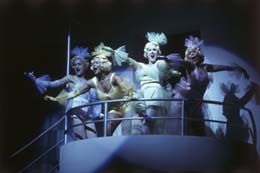 |
| Les
Blondes (from left, Saffron Henke, Maya Thomas, Wendy Spurgeon-Couraud
and Nicol Foster) perform at the Hotel Monte Gabriele in the OSF's production
of "Idiot's Delight." Photo by David Cooper. |
OSF's Idiot's Delight:
A Wise Man's Nightmare-
Robert E. Sherwood's 1936 Idiot's Delight-stunningly staged in the Bowmer-was
the best of the current OSF productions-and not only in my estimation.
Patrick Hoffman-Chief of the NYPL's Lincoln Center Library for the Performing Arts Theatre on Film & Tape project-had asked me to check it out as a possibility for the permanent archive. I gave it my enthusiastic endorsement, so I hope it has by now been taped, as it must close on 14 July.
The smartly elemental Art Deco setting-a curvbed staircase before an immense window looking out on the Italian-Swiss Alps, descending into a chastely svelte lobby-looked like an homage to the original Broadway set-design. If not a direct steal…
OSF's estimable and longtime stage-designer, William Bloodgood-second only to Richard Hay in design-talent and service to the festival-created this wonderful Art Deco evocation of 1930s elegance.
I can't find Lee Simonson's The Stage Is Set for a photo of the original for confirmation. Or was that in some other source? When I retired from teaching a decade ago, I gave all my theatre books to my former students. I thought I'd never need them again… I was going to concentrate on my Romance With Images: INFOTOGRAPHY.
Mara Blumenfeld's Art Deco costumes for Idiot's Delight recalled the Great Days of Pre-War Paris Couture. Before anyone thought Americans would one day dominate the field of Fashion. Her military outfits were more mundane, less impressive.
What's amazing about this 1936 drama is that Sherwood foresaw the outbreak of World War II in 1939. In Sherwood's vision, Axis [of Evil] Italian bombers attack France, their former ally in World War I.
Immediate French retaliations on the nearby Italian Airbase spark the Second World War. So the interesting gallery of International Types-shortly before, stranded in the hotel because of visa problems, or actually on honeymoon-immediately take the last train out of Italy.
Central to the drama is the American song-and-dance man, Harry Van, debonair but desperate. Michael Elich is splendid in this role. He's trying to get his quartet of American Lovelies over the border to their next engagement.
They are all indeed charming, pert, and wise-cracking, with memories of the fabulous Josephine Baker in the casting. Their musical numbers, with Van featured, make one long for some real musicals on Ashland's stages.
I was told, however, that for some professional reasons-unlike most actors in New York, who have to be able to sing and dance as well as act-most OSF performers cannot do both plays and musicals. It was suggested to me by a local critic that most aren't up to Broadway standards.
But it's not just a matter of engaging Equity performers, who also have memberships in other performance unions. You cannot afford to pay an orchestra for an entire season, when it plays only four times a week in repertory.
Robin Goodrin Nordli-as the mysterious White Russian, Irene-was an intriguing foil for Harry Van. Her accent was as thick as her maquillage-both covering up a checkered past, which included Van in a one-night-stand long ago in the American Middle West.
William Langan effectively subbed in the role of the villainous and indifferent international arms-merchant, Achille Weber. Nothing of the Shavian Undershot or Major Barbara about his cold-blooded Ministry of War.
Peter Amster directed the large and generally admirable cast. Sherwood's short-hand national-stereotypes-coupled with formula melodrama-didn't make matters easy for them.
So the surprise was that this production was not just an excellent evocation of a now historical period in Modern History [and Design]. But it was also oddly resonant of recent sabre-rattlings at home and actual confrontations abroad.
Who would have thought that Robert E. Sherwood had so much blood in him?
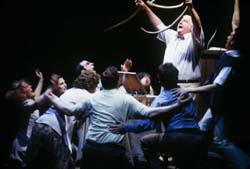 |
| Bob
(Kenneth Albers) leads his congregants in handling snakes. Photo by Jennifer
Reiley. |
Leaping Lizards?
No: Faith-Based Snake-Handling!
Years ago, Laura Linney's dad, Romulus Linney, wrote a gripping play about some
North Carolina Hill Folks and their peculiar cult of handling poisonous snakes.
Robert Schenkkan's prize-winning Handler returns to the same kind of people and locales, but with even more powerful dramatic effects. Even if his actors use fake snakes.
Instead of the real ones handled by Linney's performers in Holy Ghostly. A friend who was in that Off-Broadway cast told me she was constantly terrified of the serpents, even though none was actually poisonous.
In the Here & Now, however-which Time Magazine recently advised us may be The End of Days-Fundamentalist Christians are looking forward to a fulfillment of the arcane prophecies in The Book of Revelations.
This involves the final Battle of Armageddon, between the forces of Christ and the Anti-Christ, Satan. The actual site long long ago foretold is Megiddo in Israel. And it's not inconceivable that Israeli tanks and Palestinian suicide-bombers might clash on that fateful field.
Fortunately for the right-believing, right-thinking, right-acting Fundamentalists, they will all instantly be caught up in a Rapture, lifted live into Heaven-without the customary formalities of Death, Embalming, or Burial.
So the beliefs of the Snake-Handlers-based on a text in the Gospel of John-that they shall lift up serpents and not be stung is certainly Faith-Based, if questionably interpreted in practice.
The catch is that you have to Believe very fiercely that you will not be bitten. Or, if so, that you will not suffer the natural consequences.
Just released from prison, the elementally alienated Geordi [Jonathan Haugen] cannot fit in. He cannot throw off his sense of helpless guilt in the death of his child. Nor can his hard-pressed wife, Terri [Robyn Rodriguez], forget or forgive.
At their little church-gathering, others are inspired by a kind of religious ecstasy to pick snakes from the box on the pulpit. But Geordi makes a snake to bite him on the neck, apparently seeking death or at least freedom from life.
As the portly Good Old Boy Bob, leader of this strange sect, Kenneth Albers is right on target. His concern for his church and his parishoners is genuine-even with a bit of Bible-thumping snake-oil mixed in.
What makes this play so immediate and touching is Schenkkan's lack of satire or patronizing in treating the Belief and its People. They are the poor, the ignorant, the left-behind, the maimed, the desperate, diseased, & dying-at the bottom of the ashes of the American Dream.
That they are Southern does not really localize their sufferings and losses. All over America, there are people like these. Most would run from a snake, but all look to the Holy Bible for hope in ever uncertain times.
Faith-Based Charity will not really help them at all. What Schenkkan shows is that they need each other even more than they need their Faith.
At the close, Terri finds a strangely changed Geordi in the forest-after he has climbed out of his coffin at his funeral, shocking the mourners.
His Life-After-Life Experience is terrifying. Nothing like that expected by his snake-handling neighbors. Nor remotely like the Rapture currently expected by Last Days fanatics.
What Terri and Geordi experience in each others' arms is not what is now popularly craved as A Healing. They settle for What Is; for what they have: each other. It's not much, but it's a start…
Bill Rauch directed the able cast-who doubled and tripled in various roles. Richard Hay's simple designs were very effective in letting the play speak through the actors.
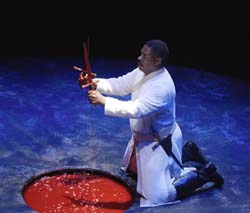 |
| Macbeth (G. Valmont Thomas) confesses his
deadly deed. Photo by David Cooper. |
Out, Out Damnèd Spot!
Macbeth With a Pool of Blood-
Possibly I should recuse myself from testifying about this strange staging of
Shakespeare's "Scottish Play."
Ashland's season stretches from mid-winter to November, thanks to its two indoor theatres. So, shortly after this Macbeth bowed, on 26 February, friends in Oregon began sending me adverse reviews of the production.
Then, in mid-May, in Reno, Nevada, longtime fans of the OSF told me in detail of the horrors they had seen on display-few of them of Shakespeare's devising, as they thought.
Two weeks later in Houston, other theatre-world-travelers repeated these indictments to me.
As this was to be my first Ashland experience this summer, I was even more uneasy when I was offered a ticket to Albee's Who's Afraid of Virginia Woolf? instead.
The sad reason was that Lady Macbeth's mother had died the night before, and she could not possibly play the murderous usurper. Briefly, I thought of Macbeth's comment: She should have died hereafter.
That was a totally inappropriate response-even though I insisted on seeing the production anyway. The excellent but grief-stricken BW Gonzalez was replaced by the admirable Maya Thomas.
But that was not the only death to require an understudy to go on. Nancy Lee-Painter took the roles of Suzanne Irving.
After the show, I was asked what I thought of the production-having been told they were understudies, with no experience of a full audience in performance. Quite honestly, had I not known that, I would not have known they had not been playing the roles all season!
That was taken as a compliment-as I guess it should be-but it did occur to me that it could also be taken as a snap-judgment that the rest of the cast was indistinguishable from the understudies…
As the Thane of Glamis and Cawdor, G. Valmont Thomas didn't promise much as the King Hereafter. Some of his local fans assured me he is better in comedy, but I have seen him before, and I find he is much given to bellowing. Sound and Fury, signifying not very much…
He could certainly profit from strong direction, but the directorial focus in this production seemed to be elsewhere. It's rumored that director Libby Appel is disappointed that Shakespeare has provided so few roles for women.
So she has obviously decided to Do Something About That. Aside from Jeffrey King's very bloody Banquo, all the other roles in her severely edited version of Macbeth are played by three women.
Even with a full complement of actors-of which the OSF has a bulging roster-a female Duncan or a Macduff do not seem ideal casting.
This was made even less effective-and less convincing-as actors often had to change costume-props in full view of the audience to assume other identities. This was confusing in the extreme, for the distinctions in characterization, if not in the lines, was not as great as was needful.
Julie Oda is a very good actress, but she is, like that young lady in Midsummer Night's Dream, lowly of stature. As the other two actresses in this particular performance were also hardly statuesque, the visual effect was rather like a school-production. Well-intentioned, fast-paced, but greatly in need of imposing actors of real Presence.
It remains a riddle why the director thought Macbeth needed to be cut. It is already the shortest of Shakespeare's dramas.
I was told that she wanted to emphasize Shakespeare's Essence in that play. But I thought he had done that already very well by himself…
Although it was almost a throw-away line, as it often seems in full-texted productions, Banquo's cautionary remark to Macbeth-that prophetic citations of fact, followed by enticing speculative suggestions, can lure men into acts of evil-was resoundingly demonstrated in action. Banquo's comment may be played as an observation, or, more powerfully, as a fearful warning…
Outdoors in America's First Elizabethan Theatre-
A Trio of Problematic Shakespearean Dramas:
 |
| Polixenes (James Newcomb) appears in disguise
to Perdita (Tyler Layton) in "The Winter's Tale." Photo byJennifer
Reiley. |
Christmas Revels Turn Deadly:
The Winter's Tale in Darkest Sicily-
It is fortunate that the Normans, rather than the Moors, conquered Sicily. Otherwise,
Michael David Edwards' Ashland staging of The Winter's Tale could not
have opened with a great tall silvery stylized Post Modernist Christmas Tree
thrusting upward toward the Musicians' Gallery.
Muslims do not have such Pagan Symbols. Nor do they have Christmas, for that matter. Think of the Church of the Nativity just a few weeks ago!
But in the festive Court of King Leontes of Sicily, it is time for gift-giving. But the silver-wrapped presents never get opened. In an instant, the fraternal affection and concern of Leontes for his demi-brother, King Polixenes of Bohemia, turns into a murderous jealousy.
On no grounds whatever, he accuses his virtuous and loving queen, Hermione, of having Bohemia as a lover. Even to the point of suspecting his beloved son, Mamillius, of being Bohemia's bastard.
This is the problematic flash-point of this drama of loss, remorse, search, and reconciliation. A famous [here nameless] director once told me: "You just have to have them say the lines very fast and get past it, so you can get on with the rest of the play."
The excellent John Pribyl does not finesse this meteoric volte face in emotions. But then very few actors have.
Fortunately, designers Michael C. Smith [settings] and David Zinn [costumes] have provided a first-act scene of glittering elegance. The Royal Court is strikingly handsome: the men in fairly contemporary formal dress, with the women all in rich red satin flared gowns.
The King's blood-red rage plays out against the Queen and Polixenes against three levels of blood-red curtains, masking the Gallery, Balcony, and Inner Below of the Elizabethan stage-front.
The apparition of Father Time-to indicate indeed the Passage of Time-was something of a trendy novelty, however. Even more up-to-date, if you will, than Act I. A mock-up of a Space Ship descends from the Heavens, and Time is disclosed as an Astronaut!
The second section-with innocent but lusty shepherds near the Seacoast of Bohemia-has nothing to do with the contemporary Czech Republic whatsoever. Instead it is San Francisco's Haight-Ashbury Hippiedom revisited.
Tudor panels in green, yellow, and orange pastels replace the red curtains. And Flower Children prepare for a fest.
Ray Porter is Right On as a Hippie Con-Man Autolycus. Even his Volkswagen Beetle-its hood hiding a hoard of worthless trinkets-has a personalized license-plate: AUTO LKS!
Of course it could be argued-considering that no one else I know caught this detail-that I wasn't paying close attention to the high-jinx of Perdita and her friends.
Many have never seen this comedy in production. But I-after many summers and winters of Shakespeare here and abroad-have seen it more times than I can count. Not to mention MSND, AYLI, Much Ado, and All's Well…
So such clever design-details are always a welcome reprieve from the well-worn plot-ploys and replays.
Unfortunately, the designers did not opt for visualizing that famous Shakespeare stage-direction: "Exit Antigonus, pursued by a bear." [Second only to: "Enter Lavinia, ravished."]
As Paulina-who often comes across as a virago nag-Demetra Pittman was firm with the errant king, but not without compassion for his certifiable lunacy. She might have been a bit more magisterial than maternal.
Kenneth Albers' Camillo was compassion and wisdom personified. A snake-handler in another age and land…
As Bohemia, James Newcomb didn't have kingly stature either visually or emotionally. He could have been a well-fed palace major-domo.
Tyler Layton's Perdita is pretty enough, but I was not the only spectator who could hardly hear her. Some voice-lessons in breathing, projection, and articulation would not be amiss. Unless Ashland assumes all their actors are already fully formed.
Actually, Queen Hermione doesn't have much to do, but Catherine Lynn Davis did it very well.
Ashland avoided a modern production stunt: To have both the Queen and Perdita played by the same actress. This is tricky when Perdita must look on the image of her long dead mother, but directors and designers have finessed it.
[This is even more difficult in The Comedy of Errors, when directors decide to have the same actor play both Dromios!]
I was going to make this a short report on the OSF, but I cannot ignore the good work of Christopher DuVal and Michael J. Hume as Bohemian Rustics.
 |
| The Goths
are brought to Rome as prisoners: Tamora (Judith-Marie Bergan) with her
sons Chiron (Cristofer Jean, bottom left), Demetrius (Gregory Linington,
bottom right), and Aaron the Moor (Derrick Lee Weeden) and the Nurse (BW
Gonzalez). Photoby Jennifer Reiley. |
Give Me a Hand, Titus!
Titus Andronicus is even more challenging to stage than Winter's Tale, but for quite a different reason. Instead of changing his mind and emotions in an instant, like Leontes, the stupidly loyal Roman General Titus continues to obey and serve a vicious, corrupt, hateful Caesar [Ray Porter], who intends to humiliate, maim, drive him mad, and ultimately destroy him.Because of his blind pride and intractable will, Titus' male line is virtually obliterated. His unfortunate daughter, Lavinia [Julia Oda], is raped, with her hands amputated and her tongue cut out, to prevent identification of her ravishers.
At the instigation of the [Axis of] Evil Moor, Aaron [Derrick Lee Weeden], Titus even foolishly cuts off his own hand to win release of his imprisoned sons.
But then this is Shakespeare's own version of an Elizabethan Revenge Tragedy, in the mode of The Jew of Malta and The Spanish Tragedy. But with even more blood, gore, and senseless horrors.
In the current production, the best moments come when the monstrous Queen of the Goths, the ferocious Tamora-once Titus' captive, but now Empress of Rome-comes disguised as a demonic goddess, to drive Titus deeper into madness. This is a Masque Moment of rare inspiration. Judith-Marie Bergan transforms herself, in the course of the drama, from venomous beauty to malignant harpydom.
William Langan, an estimable actor, sets himself an almost impossible task in the initial scene. He begins as a roaring Titus, with no higher vocal or emotional range for his rage and sufferings carry him to. Modulation and building up of pent emotions would have made his Titus more terrible and pitiable.
James Edmondson staged the large cast. William Bloodgood differenced the Elizabethan Stage façade with sets of heavy timbers on both side of the stage-pillars, as if to shore up the crumbling walls of Rome, faced with Gothic attacks. Three heroic but broken elements of a gargantuan gilded statue were standing on two stage-levels.
Susan Tsu's elaborate costumes were variously martial, menacing, imperial, fantastic, and degenerate. At the fatal final banquet-where Tamora and the Evil Emperor feast on meat pies made of her sons-the devilish duo are dressed as for a grotesque Masque.
Those who have seen the Titus film of The Lion King's Julie Taymore could have wished that some of her visual and directorial insights had been borrowed for this production. It was ultimately a Downer, but not in the way Shakespeare might have imagined…
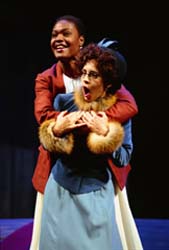 |
| Rosalind
(Deidrie Henry) and Celia (Vilma Silva) in "As You Like It."
Photo by Jennifer Reiley. |
Shaw's Shakespeare Says:
As You Like It means it is Not as I Like It!
But then, playwrights working on commission cannot be choosers, can they? Shaw's
Shakespeare, in Dark Lady of the Sonnets, obviously never had a Guggenheim
or a Rockefeller Grant!
Nor a tryout at Playwrights' Horizons, or the New York Theatre Workshop.
Surely some trendy Dutch director-Evo von Höve, perhaps?-could make something truly avant-garde out of As You Like It, this collection of famous rhetorical set-pieces? With two boy-actors disguised as women disguised as romantic young men.
The British all-male AYLI was rude, lusty, busty fun, but why not try it with altar-boys as the various women? That would be really trendy.
But Ashland may be on the way to trying it with an all-female cast. Old Adam has this season been transformed into Adda, with indicated changes in Shakespeare's text to match. Dee Maaske is very sympathetic in this guise.
But the casting of the royal cousins, Rosalind and Celia, seems a bit perverse. The larger-than-life Rosalind of Deidrie Henry-bursting with energy-should strike terror into the heart of any man who would accost her/him as either maid or youth.
On the other hand, the customarily timid, delicate, but lovely Celia is made to look-with librarian's glasses, frumpy wig, and priggish Edwardian costume-rather like a prudish Old Maid in the Making. Vilma Silva's comic miming reinforces that impression.
For once, Shakespeare's final coupling of Celia with Orlando's reformed evil brother seems charity on his part, rather than on hers.
Neither the good nor the evil Duke seem enough in command, even of himself, to rule a kingdom. Let alone run the Ashland Post Office. They both lack Authority and Presence, although they have proved competent in contemporary roles.
For the record, Kevin Kenerly is acceptable as Orlando, without being another Tom Cruise. But, Thank Zeus, not another Adam Sandler!
Both Jacques and Touchstone, however, are admirably cast, in the estimable persons of Richard Howard and Dan Donohue.
Penny Metropulos has staged with a sure eye for pacing and interactions, as well as a well-attuned ear for the textual comedy.
Although Ashland's Hippie Bohemia is a great favorite with audiences, the current production of AYLI, in its entirety, is a clear winner.
Nonetheless, it may be something of a disappointment for those regulars who each season wait to see how designers will "difference" the handsome Elizabethan façade of the outdoor stage.
Michael Ganio has completely negated that famous stage. He has designed a high wooden fence to virtually obliterate all but the pillars holding up the Heavens' roof.
In front of this-which has rear access through four doors concealed in the fence-slats and a central opening-the action is largely played on a raked oval disk. This elemental conformation could be played anywhere: in the High School Gym, on the Safeway Parking Lot…
Frankly, I thought this a bit of a cheat. I wanted to see the façade again transformed-as in the previous two productions and in all past seasons.
Worse, this quasi-scenic milieu is not very interesting or attractive. It serves the comedy, but it doesn't heighten or add to it in any way. Deborah M. Dryden's colorful costumes have to take up the visual slack. Along with some amusing set-props such as the poems to Rosalind.
Ashland 2003 at a Glance-
In the Outdoor Elizabethan Theatre:A Midsummer Night's Dream & Richard II, by Wm. Shakespeare.
Wild Oats, by John O'Keeffe.
In the New Theatre:
Antony & Cleopatra, by Wm. Shakespeare.
Lorca in a Green Dress, by Nilo Cruz.
The Continental Divide: Mothers Against, by David Edgar.
In the Angus Bowmer Theatre:
Romeo & Juliet, by Wm. Shakespeare.
Present Laughter, by Noël Coward.
Hedda Gabler, by Henrik Ibsen.
The Piano Lesson, by August Wilson.
The Continental Divide: Daughters of the Revolution, by David Edgar.
Ashland at Its Apex?
Or Is the Best/Worst Yet To Come?
A very recent issue of i>Historic Preservation features a major article
about Ashland: Too Good To Last? This has understandably caused a lot
of comment in the community and in the Festival.
Author Wayne Curtis notes the subsequent fates of many small "untouched" locales which make the annual list of Ten Most Livable American Towns or Cities. Rumors of Quality of Life, Good Schools, and Pollution-Free Environment all too often attract so many newcomers-with no stake in the communities-that the very values sought are soon destroyed.
Ashland is different from almost all of these, mainly because of the Oregon Shakespeare Festival, the town's principal industry. Without it, the old Victorian mansions would still be decaying. If not already long-vanished…
Without the Festival, there wouldn't be the vibrant Cultural-and Counter-Cultural-Life which has developed over the years. Nor would there be all those luxury shops and multi-ethnic restaurants.
For some decades, the OSF has been attracting both Shakespeare fans and travel-loving retirees who often discover that Ashland and the Rogue River Valley are ideal places to sink down retirement roots.
But such success can lead to over-population and over-development. The secure pensions of the Over Sixties drive rents and house-prices up beyond the budgets of the young marrieds and young artists so necessary to the renewable life of a viable community.
Solid Senior Citizens from outside Oregon may-and often do-build handsome houses in or around Ashland. But these do not usually pass on down to children or grand-children. And some new-home-builders soon pass on themselves. Or move on to newer Quality of Life Towns…
So the Festival Management, Southern Oregon College, and the larger community are carefully considering the warnings and prescriptions offered in Historic Preservation!
There is also a lurking danger that the Festival can become too large-even too self-confident-for its own good. This summer some Seniors with whom I talked about the productions seemed increasingly disenchanted, remembering fondly some seasons gone by.
But Memory plays us tricks in Old Age. We also remember that the Winters were warmer then-even before Global Warming gave the lie to this fond fiction.
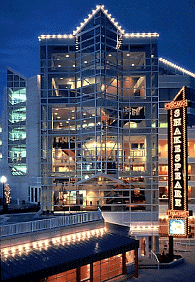 |
| COMPLETE TRANSPARENCY ON NAVY PIER--Dazzling new theatre-complex of Chicago Shakespeare Theatre. Photo: ©Steinkamp/Ballard/2002. |
Shakespeare in Chicago-
On the Navy Pier, No Less!
The Chicago Shakespeare Theatre doesn't have a Shakespeare
Festival like Ashland's. But its brilliant productions of selected monuments
of the Canon argue that it soon should develop one!
It does, however, program CST Fall & Spring Festivals. These feature "remarkable-and remarkably varied-performances of celebrated artists from Chicago, America, and abroad." But Stephen Sondheim's Pacific Overtures, however wonderful, has nothing to do with the Bard. And Simon Callow's callow impersonation of Charles Dickens is a Long Way Off from Will.
Fortunately, Chicago Shakespeare has two stages in its new Navy Pier seven-story home. On its sixth floor, it can experiment with a 180-seat flexible theatre-space.
The Chicago Shakespeare Theatre's recent magical & magisterial staging of Shakespeare's The Tempest demonstrates why its guiding lights, Barbara Gaines & Criss Henderson, might want to rethink-or add to-its current programming. This might well require yet another stage, however…
This wonderfully inventive show was extended so members of the American Theatre Critics Association-in the Windy City for their annual ATCA Conference-could check it out. That reprieve gave otherwise luckless Chicagoans a last chance to savor the brilliance of the Bard's text and the ingenuity of his fantasy, rediscovered in Gaines' insightful production.
The immediate problem for CST-any theatre would pray for such problems!-is that its annual three-play Shakespeare subscription-series rapidly sells out. So thoroughly that there are seldom even single tickets left for walk-in buyers.
At the ATCA performance, local fans were eager to share memories of previous CST salutes to the Bard. A Midsummer Night's Dream was often cited.
What makes Chicago's Shakespeare so very special? Why did more than 120,000 theater-fans make their way out onto Navy Pier this past season to see CST's shows?
Artistic Excellence, coupled with Vibrant Imagination, are, of course, major reasons. But there's more to CST's success than those qualities.
This is a theatre in which Shakespeare's Texts are of Prime Importance. Artistic Director Barbara Gaines and her Associate Director, Gary Griffin, thoughtfully re-examine the plays, line by line, in rehearsals with their excellent actors.
Instead of trying to divert audience-attention from challenging characters and richly metaphoric-even on occasion mystical-content with Trendy Up-Datings, French Desconstructions, or Post Modernist Concepts, Gaines and Griffin pay very close attention to the Word. And, of course, to the Words and Characters in the Context of the Play.
After all, The Play's The Thing!
That these CST Shakespeare plays come to vibrant life in the framework of an evocation of an Elizabethan/Jacobean indoor theatre brings them even closer to the time and stages for which they originally were written.
Suggested by Royal Shakespeare's Swan at Stratford-Upon-Avon, CST's handsome 1999 courtyard/cockpit theatre, with its end-stage and long central thrust, brings everyone in the audience very close to the plays in performance.
Some 510 eager spectators can view the action-and clearly hear the Bard's wonderful words-from three levels: Main Floor, Dress Circle, & Gallery.
The openness of the playing-space focuses attention on the actors as well, restricting illusionistic-or abstract-scenery to the end-stage.
This worked brilliantly for the CST Tempest shown ATCA in early summer. Because the end-stage is essentially a shallow proscenium, scenic effects within can easily establish a locale or a style for the entire arena.
And because the overhead is rigged with tracks, Ariel and five of his kindred spirits could actually fly out over the audience. As well as provide some mystical aerial feats within the end-stage.
State-of-the-art lighting instruments also suggest more than mere scenic artistry can achieve. What would we do without those shadowy Gobbo patterns from above? In addition to achieving general moods and atmospheres, more specific lighting can highlight important moments and characters.
The horrific shipwreck in The Tempest was wonderfully suggested with a minimum of scenery, but with brilliant use of rigging, lighting, and sound.
The ship image was also suggested by the central playing-space, shaped like an elongated and flattened hull. With a minimum of set & costume props, CST's powerful players brought this dark but healing drama to life and light as never before.
Thanks to Barbara Gaines' close attention to the text-and the intelligence of her actors-some of the line-readings made entirely new and different sense for me than they had in the many productions I have previously seen in half-a-century of play-going.
One often hears about-but seldom experiences-the fabled Illusion of the First Time. But this performance of was, for me, like seeing the play for the first time! Fresh and New!
Some of my more acerbic colleagues were not as exhilarated as I was, however.
Several New York City English Professors-who also occasionally write reviews-couldn't stand Larry Yando's Prospero. "He was always angry, so very angry. What was the matter with him?'
Maybe he had just finished grading English I final-exams?
Frankly, I found his forcefulness very effective, even magisterial. He is, after all, a Magus-and a Noble Duke Much Wronged.
And when his countenance and manner were tinged with concern for his daughter, Miranda [Cassandra Bissell], or, finally, compassion for errant mankind, the contrast was even more powerful.
Almost unbelievably, the entire cast was admirable. But some deserve special note: Jay Whitaker as Ariel, James Harms as the good old Alonzo, Scott Jaeck as Caliban, and Timothy Edward Kane as young Ferdinand. With a hilarious salute to the fumbling clowns, Greg Vinkler as Stephano and Scott Parkinson as Trinculo!
The Chicago Shakespeare Theatre Tempest production is so splendid it should be seen more widely. How about the Edinburgh & Salzburg Festivals? Not to overlook BAM in Brooklyn…
But there is a technical problem. As visualized by scenic-designer Neil Patel and lighting-designer Robert Wierzel, it works wonderfully in CST's special space. Can it be translated-opened-out-for other theatre-conformations?
Obviously, it would work just as well in London's Royal National Theatre Cottesloe or in Stratford's Swan. But could it be re-thought for BAM's Majestic/Harvey or San Francisco's Geary?
Fortunately, the fine costumes of Nan Cibula-Jenkins can hold their own on any stage…
Priority-booking for the 2002-2003 season on Navy Pier closed on 15 June. So if you are not a Chicagoan, you may never get to see the Coming Attractions:
Love's Labor's Lost, September-November, staged by Barbara Gaines.
Julius Caesar, December-February, also directed by Gaines.
The Winter's Tale, March-June, staged by Michael Bogdanov.
If the Chicago Shakespeare Theatre's fortunes-and productions-continue to thrive, it may not be necessary to go beyond Navy Pier for a new theatre-space. Beyond the historic buildings at the head of the Pier are a number of Post Modernist areas currently serving popular cultural appetites.
But, as staged & acted by Gaines and her cohorts, what could be more Popular than the Bard?
Extra Dividend:
Pre-Europe NYC End-of-Season Round-Up!
On 15 July, your reporter departs for Europe and the usual round of Theatre
& Opera Festivals. First stop: the Bregenz Festival, with its
unusual staging of La Bohème, set on giant cafe-tables and immense chairs,
rising out of the waters of Lake Constance!
This fest will be followed, in rapid succession, by the Munich Festival, the Salzburg Festival-under New Management this summer, the Bayreuth Festival, Dokumenta XI in Kassel, New Theatre in Berlin, the Edinburgh Festival, and the latest shows in London. After those various reports are filed on NY Theatre-Wire, I'm off to South Africa, Safari Parks, and Victoria Falls-before the 2002-2003 New York season really gets underway.
For the Record-and to clear the slate-here are the most notable new Manhattan productions seen since the May report:
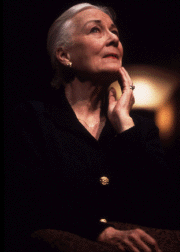 |
| "ALL OVER" BUT THE SHOUTING--Rosemary Harris is magnificent in Edward Albee's funereal drama. Photo: ©Joan Marcus/2002. |
ALL OVER [***] Rosemary Harris is a powerhouse and Michael Learned a strong foil in the elegant Roundabout Gramercy Theatre setting by Thomas Lynch. Edward Albee's labored meditation on those who wait for an unknown man's death seems even more pretentious and contrived than when it premiered on Broadway long long ago. Emily Mann stages.
CAPITOL STEPS: WHEN BUSH COMES TO SHOVE [***] These merry jesters from Our Nation's Capitol are back on Theatre Row again, in full Bush-Whacking Mode! Some sage said Irony Is Dead after 9/11. Don't you believe it! Nor is it Treason to mock Our Leaders & Legislators when they behave famously fatuously…
DEATH IN VENICE [*****] The almost ascetic Giles Havergal salutes Thomas Mann's Aschenbach at his monument and is then transformed into this tormented man, driven mad by an illicit passion for a beautiful boy. Chief of the Glasgow Citizen's Theatre's Artistic Triumvirate, Havergal magisterially performs colleague Robert David MacDonald's adaptation of Mann's despairing fable at the Manhattan Ensemble.
ENDPAPERS [****] The survival of a small Manhattan publishing house-with high standards but outmoded methods-is at issue in Thomas McCormack's fascinating insider melodrama. at the Variety Arts.
FIGARO'S WEDDING DAY [****] A jolly romp, with music by Charles Berigan instead of Wolf Mozart. The Jean Cocteau's premier comedian, Christopher Black, is Figaro to Amanda Jones' Susanne.
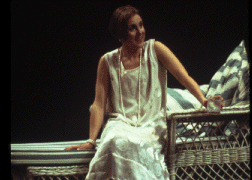 |
| F. SCOTT
FITZGERALD AT THE MET--Dawn Upshaw as Daisy Buchanan in "The Great
Gatsby." Photo: © Winnie Klotz/2002. |
THE GREAT GATSBY [***] Even the movie-version was more effective than John Harbison's opera. Who said Gatsby and Daisy had to sing anyway? But Mitch Yeargan's sets for the Met were impressive. And Jerry Hadley and Dawn Upshaw did their best in oddly flat roles.
JOE & BETTY [**] Murray Mednick won a New-Playwriting prize with this reworking of his own parents' bitter squabbles in Catskill poverty & despair. I even contributed to the pot which funds these awards, but this is not a prize-winner in my book. At the Jose Quintero, the production was relentlessly strident.
 |
| VINTAGE CAR/VINTAGE
PLAY--Arthur Miller's "Man Who Had All the Luck" at the Roundabout/American
Airlines Theatre. Photo: ©Joan Marcus/2002. |
THE MAN WHO HAD ALL THE LUCK [**] It may be seen as a dis-service to America's Senior Playwrights to revive their mercifully forgotten failed dramas. Especially their earliest work, when they were still trying to figure out how to create real characters to animate or illustrate Moral Precepts. At least the Roundabout's production shows how Arthur Miller's All My Sons and Death of a Salesman originated.
THE MURALS OF ROCKEFELLER CENTER [****] You can still see Diego Rivera's controversial Rockefeller Center Mural in Mexico City, at the Palacio de Bellas Artes where Rivera replicated the original, destroyed at the order of John D. Rockefeller, Jr. Author/director Jim Niesen and the Irondale Ensemble have created a fascinating new stage-work, worthy of Bertolt Brecht's Epic Theatre and John Dos Passos! Among the cast of characters: Chas. A. Lindbergh, J. Edgar Hoover, Henri Matisse, John Dillinger, Frida Kahlo, Henry Ford, Norman Schwarzkopf, Calvin Coolidge, Melvin Purvis, Ben Shahn, George Gershwin, William Powell, Pablo Picasso, Clark Gable, Will Rodgers, Lucienne Block, Nelson Rockefeller, Dwight Morrow, Anne Morrow Lindbergh, and, of course, the irrepressible Rivera himself! This fascinating new work should be seen at major festivals-and mounted by American Regional Theatres as well!
NOCHE FLAMENCO [****] The New Victory Theatre triumphs again, programming a vibrant dancing & singing flamenco ensemble which entrances children, animates teens, and electrifies adults.
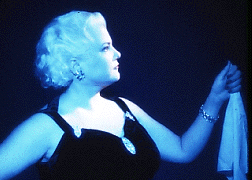 |
| RED
HOT MAMA--Sharon McKnight as Sophie Tucker. Photo: ©Halpin/Croyle/2002. |
RED HOT MAMA [***] At the York Theatre, Sharon McNight is as close as you can come to a replica of Sophie Tucker, with costumes and attitudes to match her fabled persona, unfortunate loves, long career, and risqué songs.
THE SANDMAN [***] David Herskovits' Target Margin Theatre hits the margin of the target, not the bullseye, with this reworking of an E. T. A. Hoffmann tale. Although composer Thomas Cabaniss is not yet J. Offenbach-and certainly a long way off from J. S. Bach-his new score does justice to some interwoven Tales of Hoffmann. The six young singers are all outstanding-take note, NY City Opera! But their performances are deliberately interrupted, even crippled, by stupid stage-business, which passes for Target Margin's Special Style.
SELF DEFENSE OR DEATH OF SOME SALESMEN [***] Serial-killer Aileen Wuornos earned more than her allotted 15-minutes of fame by offing some unfortunate but horny males. Thanks to Carson Kreitzer's script and Lynne McCollough's raw, rebellious performance of Jolene Palmer, the Wuornos stand-in, audiences can understand-if not excuse-what she did.
THIS THING OF DARKNESS [*] John Simon hated this play & production at the Atlantic. He could not make sense of it. He is not alone! Chums comparing their penises, plus cross-dressing, Nuclear Holocaust, and Time Inversions make one wonder where Craig Lucas' former talent for mind-bending fantasy has fled…
VIENNA: LUSTHAUS (revisited) [*****] It's a long time since Martha Clarke has had a real avant-garde success. Walt Whitman and Flora, the Baby Elephant, nearly did her in at BAM. Now she has returned with a reworking of her 1986 classic of Freudian Ferment in Fin de Siècle Vienna. Or, as the Austrians might say: Wien um die Jahrhundert-Wende… That excellent dancer Rob Besserer is gone, but the elegant ensemble-costumed and environed by Robert Israel-wonderfully evokes Time, Place, Atmosphere, Mood, and Fundamental Repression. Now it's time for a revival of Clarke's haunting Miracolo d'Amore, also with Richard Peaslee's stunning score! [Loney]
Copyright © Glenn Loney 2002. No re-publication or broadcast use without proper credit of authorship. Suggested credit line: "Glenn Loney, New York Theatre Wire." Reproduction rights please contact: jslaff@nytheatre-wire.com.
| museums | recordings | coupons | publications | classified |